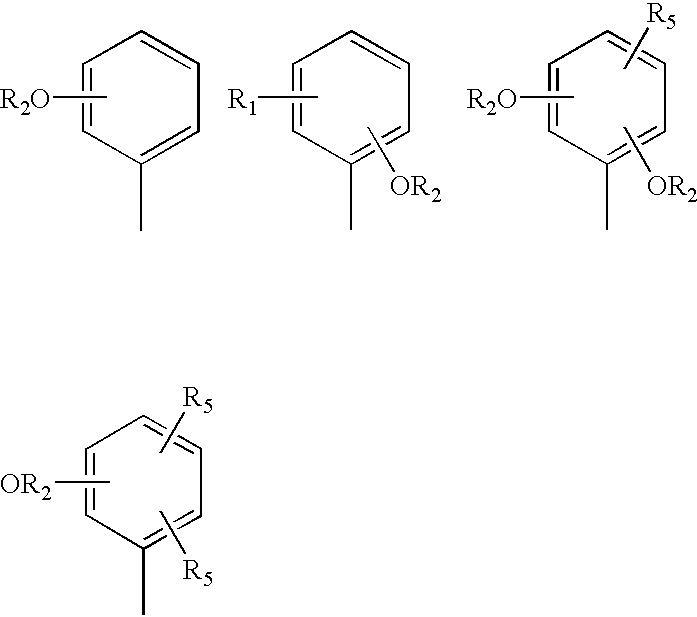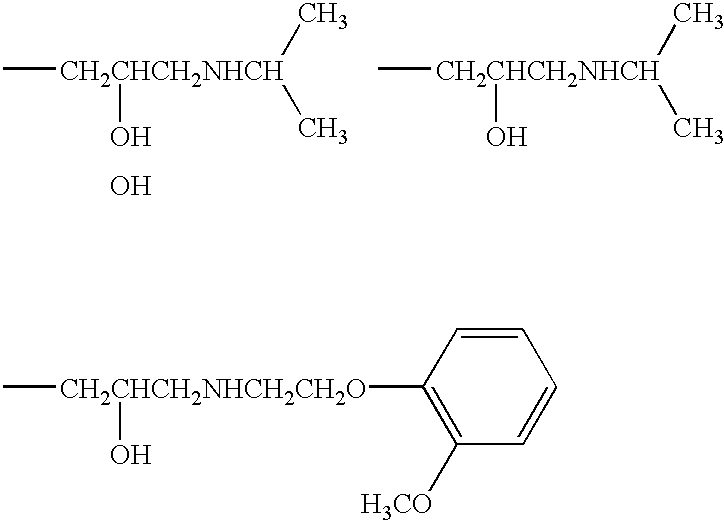1,4-dihydropyridine derivative with a guaiacoxypropanolamine and/or phenoxypropanolamine moiety
a technology of guaiacoxypropanolamine and phenoxypropanolamine, which is applied in the direction of biocide, drug composition, cardiovascular disorder, etc., can solve the problems of affecting experimental accuracy, cumulative administration of propranolol did not produce any relaxation effect, etc., and achieve dose-dependent vasoconstriction and inducible vasoconstriction
- Summary
- Abstract
- Description
- Claims
- Application Information
AI Technical Summary
Benefits of technology
Problems solved by technology
Method used
Image
Examples
example 2
Synthesis of Compound 2
[0223] 0.2M of 2-methoxyphenol and 0.4M of Ethylene dibromide were heated till boil in a triple-necked flask, and mixed with a rod for 30 minutes. 125 ml of 1.6N sodium hydroxide was added, and heated with mixing until layers were divided. After heating overnight, TLC was used to ensure complete reaction, and CHCl.sub.3 was repeatedly used to extract the organic layer.
[0224] 300 ml of 2N sodium hydroxide was used to rinse the organic layer, before magnesium sulfate anhydeide was added and left overnight. Then the compound was filtered, decompressed to concentrate, and purified by silica gel column chromatography, eluated with hexane:ethylacetate=9:1, and the first intermediate product 2-methoxy-1-oxyethylbromide benzene was thus obtained.
[0225] Using similar molar of potassium phthalimide to perform the above mentioned procedure, 2-methoxy-1-oxyethyl bromide benzene was obtained. This was dissolved in dimethyformamide, and its temperature raised to 55.degree. ...
example 3
Synthesis of Compound 3
[0231] 8 gm of sodium hydroxide was dissolved in 100 ml absolute alcohol. 1 molar of 4-hydroxy-3-methoxy-1-benzaldehyde was dissolved in the above mentioned solution. This solution was stirred under room temperature, and 5 molar of epichlorohydrin added to react for 2 hour. TLC was used to determine whether the reaction was completed. The reaction solution was then purified by silica gel column chromatography, using hexane:ethylacetate=1:9 to eluate from silica gel column, concentrated under reduced pressure and re-crystallized by hexane to obtain N-[4-(2,3-epoxypropoxy)-3-methoxy]-1-benzaldehyde.
[0232] Similar molar of N-[4-(2,3-epoxypropoxy)-3-methoxy]-1-benzaldehyde and 2-methoxy-1-oxyethylaminobenzene were dissolved in 100 ml of absolute alcohol, and undergone amination in slight warmth. After mixing and left re-crystallized by methanol to afford N-{4-[2-hydroxy-3-(2-methoxy-1-oxye-thylamino -benzene) propoxy]-3-methoxy}-1-benzaldehyde.
[0233] 0.01M of N-{4...
example 4
Synthesis of Compound 4
[0235] 8 gm of sodium hydroxide was dissolved in 100 ml absolute alcohol. 1 molar of 5-chlorosalicylaldehyde was dissolved in the above mentioned solution. This solution was stirred under room temperature, and 5 molar of epichlorohydrin was added to react. TLC was used to determine whether the reaction was completed. The reaction solution was concentrated under reduced pressure and purified by Silica gel column chromatography, using hexane:ethylacetate=1:9 to eluate, concentrated under reduced pressure, and re-crystallized by hexane to afford N-[2-(2,3-epoxy-propoxy)-5-chloro-]-1-benzaldehyde.
[0236] Similar molar of N-[2-(2,3-epoxypropoxy)-5-chloro]-1-benzaldehyde and tert-butylamine were dissolved in 100 ml of absolute alcohol, and undergone amination in slight warmth. The reaction solution was concentrated under reduced pressure, purified by silica gel column chromatography and eluated by methanol:ethylacetate=1:1. Obtained eluate was further concentrated un...
PUM
| Property | Measurement | Unit |
|---|---|---|
| temperature | aaaaa | aaaaa |
| threshold voltage | aaaaa | aaaaa |
| length | aaaaa | aaaaa |
Abstract
Description
Claims
Application Information
 Login to View More
Login to View More - R&D
- Intellectual Property
- Life Sciences
- Materials
- Tech Scout
- Unparalleled Data Quality
- Higher Quality Content
- 60% Fewer Hallucinations
Browse by: Latest US Patents, China's latest patents, Technical Efficacy Thesaurus, Application Domain, Technology Topic, Popular Technical Reports.
© 2025 PatSnap. All rights reserved.Legal|Privacy policy|Modern Slavery Act Transparency Statement|Sitemap|About US| Contact US: help@patsnap.com



